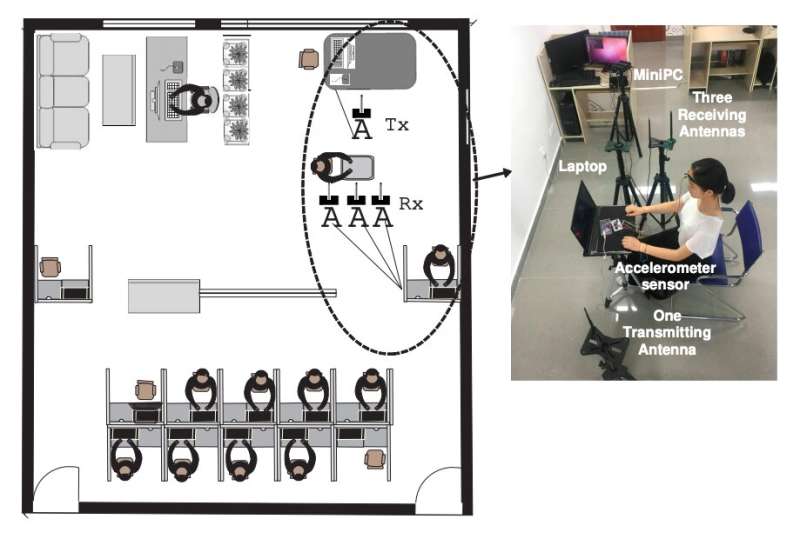September 18, 2019 feature
EmoSense: an AI-powered and wireless emotion sensing system

Researchers at Hefei University of Technology in China and various universities in Japan have recently developed a unique emotion sensing system that can recognize people's emotions based on their body gestures. They presented this new AI- powered system, called EmoSense, in a paper pre-published on arXiv.
"In our daily life, we can clearly realize that body gestures contain rich mood expressions for emotion recognition," Yantong Wang, one of the researchers who carried out the study, told TechXplore. "Meanwhile, we can also find out that human body gestures affect wireless signals via shadowing and multi-path effects when we use antennas to detect behavior. Such signal effects usually form unique patterns or fingerprints in the temporal-frequency domain for different gestures."
Wang and his colleagues observed that human body gestures can affect wireless signals, producing characteristic patterns that could be used for emotion recognition. This inspired them to develop a system that can identify these patterns, recognizing people's emotions based on their physical movements.
In their study, the researchers focused on answering two key research questions. Firstly, they investigated how body gestures can be identified by analyzing the characteristic patterns they leave on wireless signals. Secondly, they set out to develop a system that can recognize emotions based on users' body gestures.
Most existing vision-based or sensor-based tools for emotion recognition are either uncomfortable to wear, or rely on specialized hardware, which hinders their applicability in real-life settings. The system developed by Wang and his colleagues, on the other hand, is less obstructive, as it essentially works by analyzing wireless channel responses via data mining and detecting emotion based on the physical expressions that correspond to observed patterns, or wireless 'fingerprints."
"In my opinion, emotion is well-recognized as a distinguished symbol of human beings, and it plays a crucial role in our daily lives," Wang said. "EmoSense is a first-of-its-kind wireless emotion-sensing system driven by computational intelligence. The system works by exploring the physical expression of emotions from wireless channel response via data mining."
The researchers evaluated EmoSense's performance on 3360 cases and compared it to that of several existing sensor-based and vision-based emotion recognition tools. They found that it performed similarly to the other approaches, even if it does not require expensive hardware and is thus easier to implement. As it works by analyzing wireless signals, EmoSense also leads to far lower privacy-related issues.
The emotion sensing system developed by Wang and his colleagues could have numerous interesting applications. For example, it could be used during theatre rehearsals to determine whether a particular play (e.g., a comedy show) suscitates desired emotional reactions. In their future studies, the researchers plan to develop the system further while also exploring other aspects of emotion recognition.
"EmoSense and its rivals hinge upon human gestures as an expression of emotion, which still remains a blur, so far," Wang explained. "For example, dishonest people can deceive the system by intentionally behaving in certain ways. A possible solution to this problem is to leverage the multi-modality feature of emotion."
According to Wang, a key limitation of EmoSense is that it is data-driven. In other words, it relies primarily on quantitative observations without considering more complex psychological aspects of emotion.
"As psychology knowledge is also very important for understanding human emotion, it might be more reasonable to couple both data and psychology knowledge in order to attain more reliable and accurate emotion recognition," Wang added. "In addition, the physical expression of emotion is affected by many congenital and acquired factors, some of which are totally out of control. Therefore, it is important to clarify the potential scenarios before we actually deploy the system."
More information: EmoSense: computational intelligence driven emotion sensing via wireless channel data. arXiv:1908.10013 [cs.HC]. arxiv.org/abs/1908.10013
© 2019 Science X Network
















